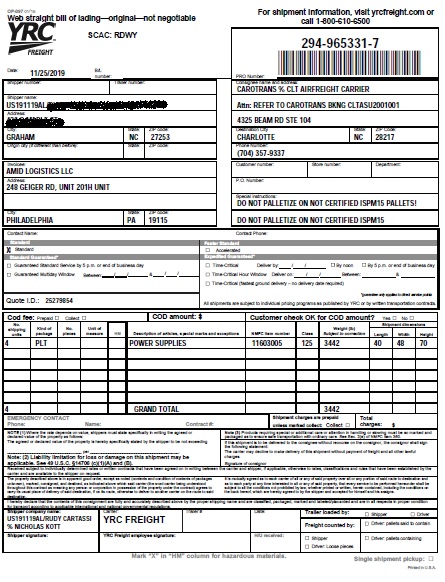|
|
U.S. Domestic LTL Bill of Lading in International Shipping via LCL
LTL U.S. Domestic Freight as a part of International Shipping from the USA
In the context of international shipping using Less-than-Container Load (LCL) service, sea freight refers to cargo transportation between Container Freight Stations (CFSs) in the country of origin and destination. CFS means a bonded warehouse under Customs supervision.
To initiate an LCL shipment, your load needs to be delivered to a CFS for further shipping from the USA overseas.
If you cannot deliver cargo to CFS and need a pickup or line-haul to CFS, this is where LTL freight comes in. It becomes part of multimodal global cargo transportation when utilizing LCL service.
LTL stands for Less Than Truckload. It refers to transporting smaller loads within the United States without incurring the cost of a full truckload.
Once your shipment arrives at the CFS, an international shipping company will combine it with other shipments to the same country and ship them overseas using LCL service.
Popular trucking companies, such as ABF, SAIA, XPO, etc., can help move your cargo from anywhere in the United States to the CFS.
By integrating ground and ocean conveyance services, shippers can efficiently manage both legs of the journey: the inland transportation and the overseas export. This two-step method benefits those seeking affordable international shipping without needing a full container. With coordination between the shipping companies specializing in different modes of transportation, goods can be securely delivered to the port of departure and continue their route to the destination country.
Do not confuse LTL & LCL Bills of Lading
Suppose you ship goods overseas with Less-than-Container Load service, but you are far from a sea carrier's terminal (CFS). In that case, you can deliver your load to the nearest LTL carrier's terminal for the U.S. domestic ground transportation (line haul or LH) to the sea carrier's terminal. Our online price calculator lists such terminals in lowercase, with an asterisk (*). For example, Orlando, FL*.
You can also select a pickup (collect) option to pick up your items "at your door" in the USA for further transportation overseas.
For U.S. local deliveries (line hauls and pickups), international shipping companies are typically supported by domestic trucking companies acting under U.S. domestic LTL Bills of Lading.
Do not confuse these documents:
-
LTL is an abbreviation for Less than Truck Load - a U.S. domestic ground transportation service designed to deliver consolidated cargo within the USA.
-
LCL is an abbreviation for Less than Container Load - a global transportation service designed for transporting consolidated cargo out of the USA by sea.
Below is an example of a U.S. domestic B/L.

A domestic inland BOL (unlike a sea freight BOL) is an intermediate document. It is NOT a final document for your international shipment. It acts as a U.S. private carriage contract for carriage goods from their location to a CFS for further exporting abroad.
In respect of global cargo transportation from the USA, besides other purposes, it verifies details of transporting goods, such as:
- The transporting commodity,
- Quantity of units and their packing,
-
The weight and dimensions.
After it is delivered to an ocean carrier, the CFS employee should verify the information in the LTL BOL. The number of pieces and their weight/measurements information on the document can be used to verify the number of pieces and w/m submitted by the shipper to the shipment until everything is palletized.
Unlike the ocean bill of lading, which is the final document in global cargo transportation, the LTL bill of lading is an intermediate document when shipping goods overseas.
Discrepancies in Bills of Lading
Please note that it’s normal to see variations in the number of boxes, pallets, or weight listed on different documents during the transportation process. This can happen between the Proof of Delivery (POD) and the inland and ocean consignments. There are several reasons for this, but it often occurs when loose items are palletized or re-palletized at freight terminals.
These changes in packaging or handling can affect how the cargo is counted or measured at each step. However, you don’t need to worry if the numbers don’t match exactly across the paperwork, PODs, or warehouse receipts from the carriers' terminals. What really matters is the final LCL BOL, which is the official document used for international shipping.
If you're the consignee (the person receiving the goods overseas), always refer to the LCL BOL for your shipment's final and accurate details. This document should be used when working with customs or recovering your import at the destination.


.png)


